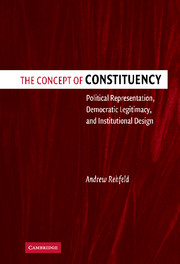 The Concept of Constituency
The Concept of Constituency Published online by Cambridge University Press: 27 July 2009
INTRODUCTION AND CHAPTER OVERVIEW
A legislature, John Adams argued in 1776, “should be an exact portrait, in miniature, of the people at large, as it should think, feel, reason and act like them.” Over two centuries later, this call for “mirror representation” works most effectively as a critique: How can a legislature of mostly white men, for example, possibly represent the wide interests and perspectives of a diverse population? Of course, it is more problematic to specify which other features of the whole ought to be added. As Pitkin noted, few would want a legislature that looked like a nation in terms of reflecting, for example, its average “intelligence, public spiritedness, and experience.” Still, the concern for mirror representation has led to legislatures that are more deliberatively heterogeneous in ways that seem reasonable, even necessary to the proper function of representative bodies. In the United States, for example, territorial districts are drawn or gerrymandered to ensure the election of minorities and political parties into the legislature. In France, throughout Latin America, and most recently in Afghanistan, democracies are experimenting with gender quota laws that would increase the number of women in the candidate pool and legislature. And the move to proportional representation has been justified by its ability to elect a legislature that is a clearer reflection of the nation's underlying ideological and political views. In short, the “politics of presence,” as Anne Phillips has called it, is gaining traction as an endorsed principle of institutional design.
To save this book to your Kindle, first ensure no-reply@cambridge.org is added to your Approved Personal Document E-mail List under your Personal Document Settings on the Manage Your Content and Devices page of your Amazon account. Then enter the ‘name’ part of your Kindle email address below. Find out more about saving to your Kindle.
Note you can select to save to either the @free.kindle.com or @kindle.com variations. ‘@free.kindle.com’ emails are free but can only be saved to your device when it is connected to wi-fi. ‘@kindle.com’ emails can be delivered even when you are not connected to wi-fi, but note that service fees apply.
Find out more about the Kindle Personal Document Service.
To save content items to your account, please confirm that you agree to abide by our usage policies. If this is the first time you use this feature, you will be asked to authorise Cambridge Core to connect with your account. Find out more about saving content to Dropbox.
To save content items to your account, please confirm that you agree to abide by our usage policies. If this is the first time you use this feature, you will be asked to authorise Cambridge Core to connect with your account. Find out more about saving content to Google Drive.